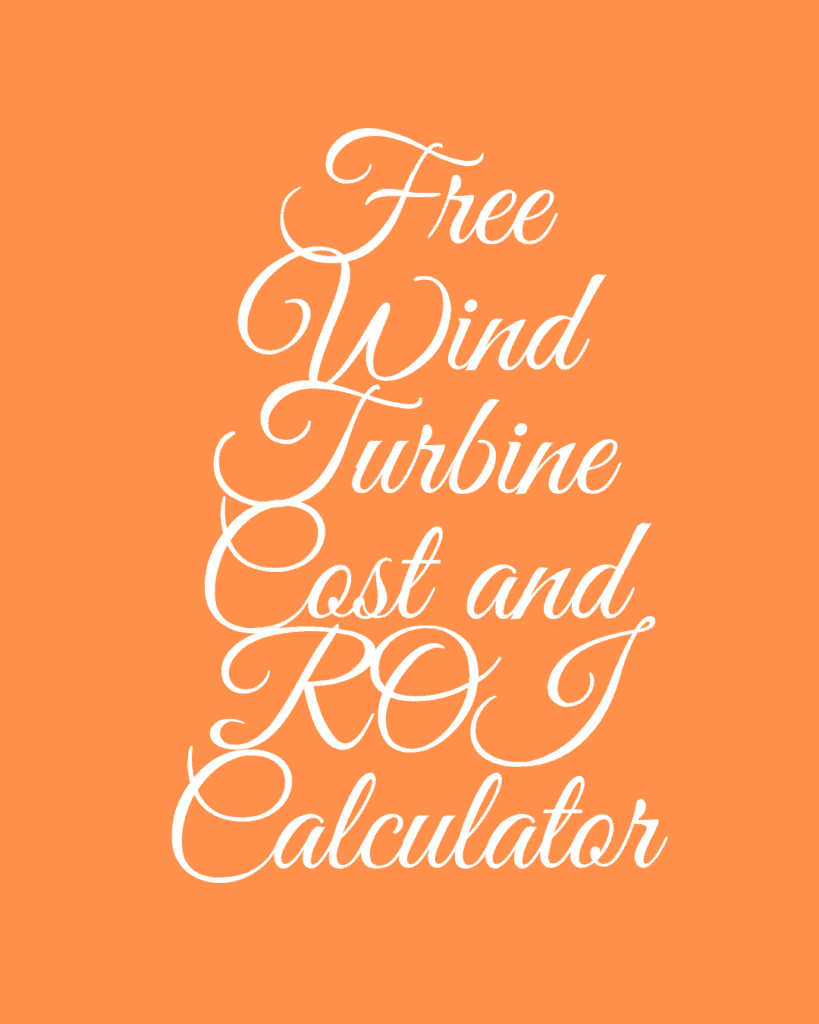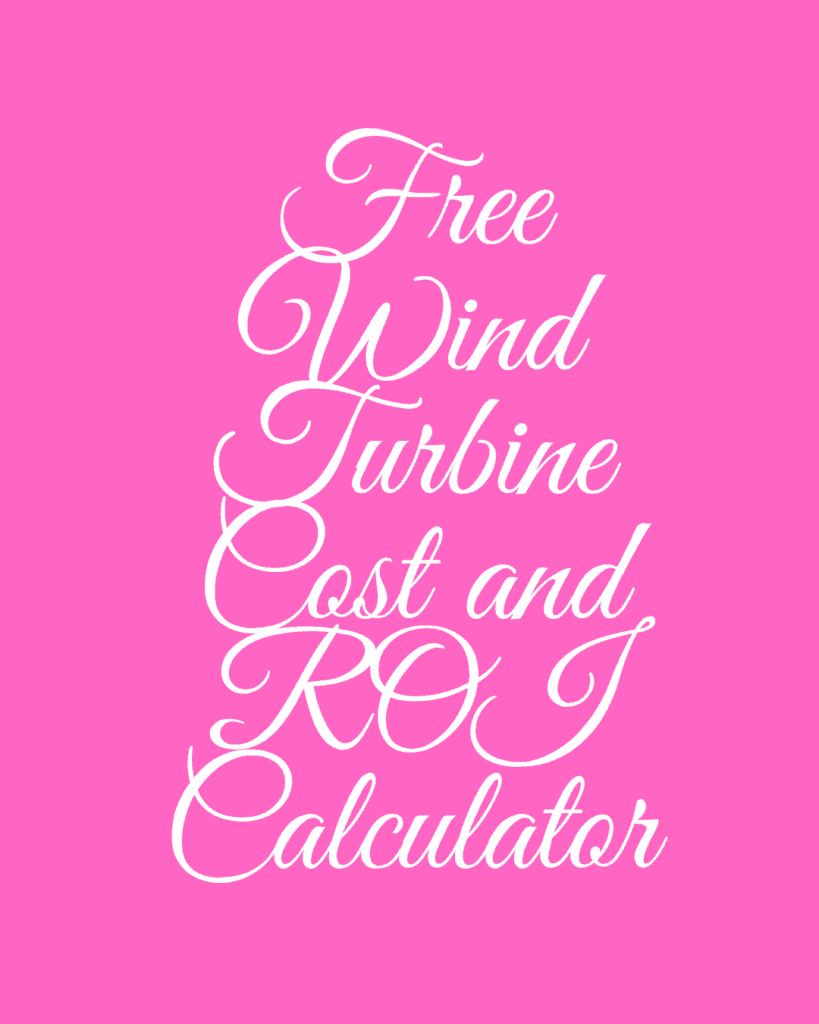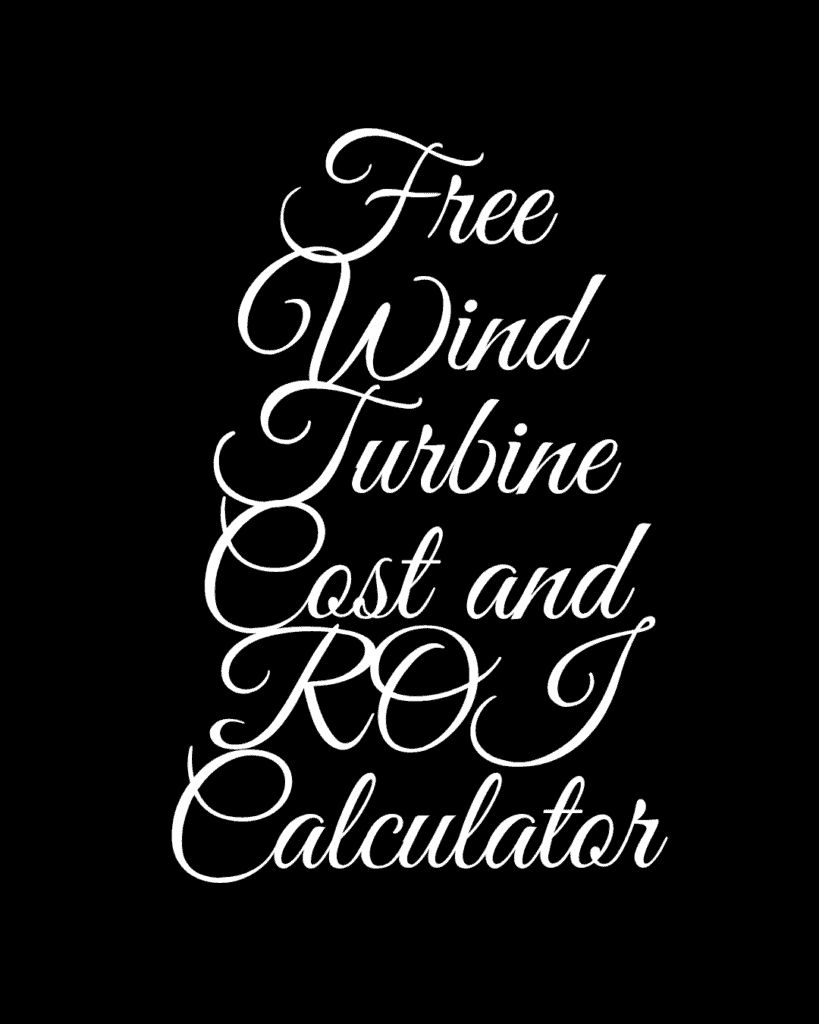Wind Turbine Cost and ROI Calculator
Wind Turbine Cost and ROI Calculator
Wind energy performance is best measured in terms of annual electricity production, or Kilowatt-Hours (kWh), produced.

Wind power systems for homes typically range in cost from $20,000 to $80,000 and take an estimated six years or less to cover an average home's energy demands. When your investment will pay back depends upon which system is selected, wind conditions at your site, and electricity rates in your region.
Costs
Wind turbine costs are an essential consideration in assessing alternative energy sources, as their price impacts overall returns on investment. Along with initial installation expenses and energy production/savings costs, electricity savings must also be factored into your calculations of payback time and period.
Cost estimates for residential wind turbines depend on several variables, such as average annual wind speed in your location and material costs. Higher winds often necessitate larger turbines constructed of more costly materials to withstand strong gusts; additionally, permitting and installation fees vary widely from community to community. Furthermore, you may even qualify for financial incentives or rebates such as Residential Clean Energy Credit which offers homeowners who install small wind systems 30% federal tax credit; some states also provide their own incentives.
Install and maintenance costs associated with commercial wind turbines can be substantial and add significant increases to their total costs, including labor, crane rental fees, grid integration fees, professional design fees as well as expenses such as insurance premiums, land lease payments and repairs.
Location is another significant factor when estimating the total cost of wind turbines, as it affects manufacturing, construction, and transportation expenses. Your local average wind speed will play an integral part in your turbine's performance; thus determining how much electricity it generates. A directional wind turbine (HAWT) captures wind more effectively than non-directional ones (VAWTs).
Once your initial installation is complete, it's important to carefully consider operational costs; which encompass ongoing expenses associated with owning and running your wind turbine, such as regular maintenance, insurance premiums and repair bills. In addition, factor in battery storage system costs as a part of that equation - usually around $6,000-13,000 just for itself with additional charges between $100-400 being added by charge controllers.

Operating costs for a 2-MW wind turbine typically run 1 to 2 cents per kWh of electricity consumed annually, or $25-$40 per kW per year. These recurring expenses cover labor, equipment rentals, insurance costs and maintenance costs.
Energy Production
Wind is one of the world's most potent natural forces, offering hope of a clean, renewable future that reduces greenhouse gas emissions while protecting natural ecosystems. Yet harnessing its energy presents its own set of unique challenges; high initial costs, intermittency, and site selection among them must all be overcome in order to unleash this green energy source's full potential.
Cost of residential wind turbines can vary considerably based on location and model choice, typically falling anywhere from $30,000 to $75,000. Installation expenses must also be factored into overall project costs when estimating total project expenses; such costs include purchasing the turbine itself, foundation preparation and electrical connections. A home owner should expect additional expenses associated with permits and construction requirements.
Homeowners can lower the upfront costs associated with wind turbine ownership by taking advantage of available state and local tax incentives and rebates, along with energy savings generated from their wind turbine. To ascertain when their initial investment will pay back in terms of energy savings generated from their wind turbine, consider your electricity usage patterns along with estimated gross annual energy production (in kilowatt hours).
Use our free online tool to determine the energy production potential of your wind turbine. Our calculator will assist in estimating how much power will be generated based on local conditions and average wind speed; then compare this estimate against your electricity costs to see how much savings could result from making the switch to renewable power.
Energy production depends heavily on wind conditions, with different turbine types producing energy at various levels and under specific scenarios. For instance, horizontal-axis wind turbines (HAWTs) capture directional winds more effectively and produce more energy than their vertical-axis counterparts, which produce power from variable winds.
Wind turbines require significant upfront investments, yet their operational costs are much less than fossil fuel-based plants. Their levelized cost of electricity (LCOE) includes capital costs, interest payments, operating costs, maintenance and transmission expenses as well as any embodied energy of components used within their systems as well as their eventual disposal costs.
Payback Period
Payback periods for wind turbines refer to the time it takes for the electricity produced by them to equal their manufacturing energy use, taking into account factors like labor and material costs, transportation fees and electricity rates. Sometimes this period can last up to a year before wind turbines pay back their investments.
Life cycle analysis, or LCA, is used to ascertain the energy necessary to manufacture wind turbines. This assessment measures environmental impacts from extraction through operation; including land and water usage as well as human impact. LCA provides the most thorough way of evaluating renewable energy source performance while at the same time being widely utilized to ascertain economic benefits.
Some social media posts have incorrectly suggested that wind turbines require years to make up the energy used in their construction and regular operation to offset their initial energy requirements, but this claim has been disproven by several studies.

Wind turbine production consumes an immense amount of energy, from mining raw materials and manufacturing the towers, rotors and rotor blades, transport and installation all taking energy resources. At the end of their lifespans wind turbines must also be disassembled and recycled - therefore when calculating return on investment (ROI), energy payback periods must also be considered when making decisions about projects.
On average, wind turbines typically offer an ROI between 7.5% and 8% depending on initial investment costs and electricity tariff rates in your location. However, ROIs can even increase significantly if there are high electricity rates or you live near an Area of Outstanding Natural Beauty (AONB).
Carbon Payback Period for Wind Turbines It is also possible to calculate a carbon payback period for wind turbines, which measures how long it will take the energy produced by their production to offset their manufacturing and installation emissions. This calculation depends heavily on various factors including production from each turbine, local electricity prices, climate conditions etc.
ROI
Before investing in a wind turbine, it's essential to understand its return on investment (ROI). Your ROI depends on various factors including annual energy production and savings, local utility rates and net metering options available from utility providers; installation costs as well as any government incentives or feed-in tariffs provided; as well as potential resale values of your turbine which could further impact its ROI potential.
Cost of wind turbines varies significantly based on their size, design and availability of wind resources in different locations. The National Renewable Energy Laboratory has released models that may assist investors and industry professionals in conducting life cycle assessments or cost-benefit analyses for various energy generation solutions; such calculations use fixed and variable costs related to investment and operations to compare LCOE across various technologies.
Wind turbines provide clean electricity that can help lower greenhouse gas emissions and improve air quality, as well as providing reliable power sources in places without access to other forms of energy. Furthermore, some wind turbines even generate more energy than they consume!
Studies on small wind turbines (SWTs) have explored their feasibility. For instance, one such study in Turkey concluded that 3 kW-capacity SWTs were cost-effective in coastal regions while other studies in Iran and Pakistan have determined they are viable in 30% of locations with average wind speeds over 5 m/s.
People tend to focus on the power output of wind turbines, but what really matters is their total energy production. When selling energy for profit, customers pay according to how many kilowatt-hours are produced rather than power per mile traveled (which only applies if selling energy through another provider).
Though ROI of wind turbines cannot be assured, it is wise to consult a renewable energy consultant and financial advisor prior to making a decision. An energy consultant can determine whether your property has enough wind for a wind turbine to support installation; they also evaluate any tax benefits you might gain as part of this investment strategy.
